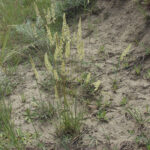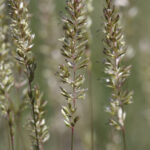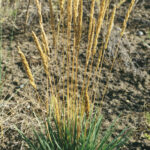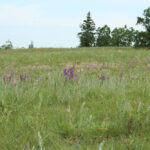Junegrass
Koeleria macrantha
General Description
Junegrass is a widely distributed, long-lived, cool season, native perennial bunchgrass. It tends to increase with overgrazing. Junegrass is a highly variable species, adapting to various environmental conditions with different growth forms. For example, there are variations in hairiness or hairlessness, and on drier sites, plants are shorter with more basal leaves. It produces narrow leaves 2 to 6 cm (1 to 2½ in) long and usually folded and hairy, but are sometimes flat.
Type
Native grass.
Origin
Native to prairie grasslands and forest meadows.
Longevity
Moderate. Early-mid successional species on many sites. Often found in mixed grasslands.
Use
Reclamation, pasture.
Optimal Time of Use
Livestock prefer to graze in early spring or late fall after curing on the stem, as this is when it is most palatable. Wildlife documented to prefer to graze it in the summer.
Recovery After Use
Requires a full growing season to recover from grazing. It is an increaser species.
Palatability/Nutritional Value
Protein content is 20% in early spring but by late fall drops off to 4%. Plants cure well on the stem so they can provide some feed value later in the season.
Annual Precipitation min/max (mm)
300mm / 500mm
Drought Tolerance
Very drought tolerant.
Flooding Tolerance
Withstands one to two weeks of saturated soils.
Winter Hardiness
High winter hardiness.
Soil Texture Preference
Well adapted, but most often found in medium to coarse soil textures and mesic to dry soil moisture conditions.
Erosion Control
May contribute to erosion control once established.
Salinity Tolerance
Not tolerant to salinity.
Acidity Tolerance
Slight tolerance.
Alkalinity Tolerance
Unspecified. Junegrass is noted to tolerate higher pH levels and calcareous soils.
Seeds per kg
3,448,000 seeds/kg (1,564,000 seeds/lb)
Suggested Mixtures
Native species for reclamation purposes.
Ease of Establishment
Germination percentages can be low (less than 50%); seedling vigour can be low, and stands are slow to establish, often requiring 2–3 years.
Competitiveness
Junegrass is not considered invasive but can spread to adjoining native plant communities under ideal environmental conditions. Often seen growing as a first-mid successional plant.
Management Considerations
Allow for adequate recovery time following grazing. Time grazing for other native species within the mix.
BC Rangeland Seeding Manual, USDA Plants Database
Junegrass is typically found in the Bunchgrass and Interior Douglas-fir zones in the southern part of the Central Interior region. It less commonly found in the Sub-Boreal Spruce and Sub-Boreal Pine-Spruce zones.
Junegrass is common in native grassland communities in all zones in the the Southern Interior region.
Junegrass is found in native plant communities in the Peace-Liard region, especially on steep southern exposures on banks of the major rivers and in undisturbed parkland areas. It is an important pioneer species on disturbed sites.



